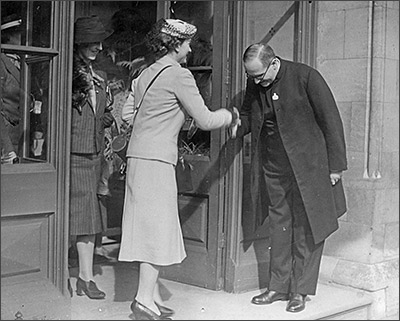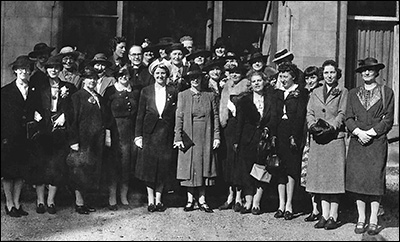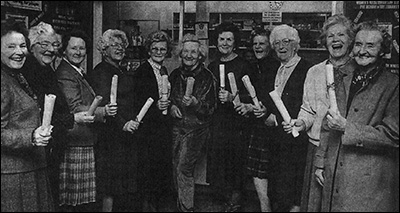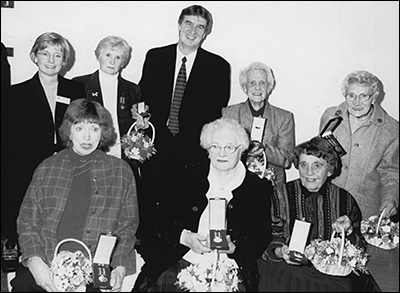|
|
|
The WVS at the Rectory c1938-9, possibly on the occasion
of the visit of the Duchess of Gloucester.
|
|
|
|
WRVS helpers 1989.
Burton Latimer members are Hilda Thurlow (2nd from left)
and Phyllis Aveling (3rd from right).
|
|
|
|
WRVS service recognised 1990.
From Burton Latimer (3rd from right) is Hilda Thurlow.
|
|
|
|
WRVS presentation 2005.
Burton Latimer recipients are Millie Westley (bottom row centre)
and Dorothy Hargreaves (bottom row right).
|
The WVS is one of the best examples of the successful mobilisation of the energies and abilities of women in the service of the Nation. As war threatened in 1938 Home Defence was at the forefront of people’s minds. It was becoming obvious many attacks would come from the air and, in 1938, the Air Raid Precautions Department appealed for one million volunteers. The response gave the Home Secretary, Sir Samuel Hoare, the idea of setting up a women’s organisation to help with the task. On 16th May 1938 the Women’s Voluntary Service for Air Raid Precautions was founded. The aim was that every woman should be given the opportunity to contribute to the defence of the country against enemy air attack.
By the time war was declared the WVS had 165,000 members drawn from groups unable to “join up” or to do essential war work – the elderly, the young, the housebound or those with dependents. Men were not excluded and occasionally helped with jobs such as driving, which few women could then do. The work quickly diversified and the organisation changed its name to the WVS for Civil Defence. The work of the WVS was organised in close cooperation with Government Departments and Local Authorities. One of its first tasks was to evacuate one and a half million children from the big cities to the country. Members also staffed hospitals, clubs, sick bays and communal feeding centres. They opened clubs for mothers, provided transport for hospital patients and undertook welfare work for the troops. As the war escalated when Germany invaded the Low Countries in 1940, the WVS distributed food and clothing donated by the free world for fleeing refugees. Clothing bought on behalf of the Lord Mayor’s Air Raid Distress Fund was distributed to the native population whose homes had been bombed out. As air raids became more commonplace in many major cities in 1941, the WVS organised rest centres for those left homeless after a raid and at the end of 1941 the WVS enrolled its millionth member.
By 1943 the WVS were staffing Incident Inquiry Points set up in the bombed localities to give information about the dead and injured. Air raids continued in London and East Anglia and during 1944 mobile canteens were set up to help with the evacuation from affected areas. The Household Gifts Scheme was started with members collecting and distributing gifts of furniture to bombed out families, many thousands having lost all their possessions without any means of replacing them. After the cessation of hostilities in Europe in 1945, WVS members were sent to South East Asia for troop welfare work and went with the troops through Malaya and into French Indo-China. By the time the war against Japan was concluded on August 15 th the WVS had coped with unimaginable difficulties, members had received many awards for gallantry and, sadly, 241 members’ lives had been lost whilst on duty.
Post war the WVS became the WRVS (Women’s Royal Voluntary Service) and today through 60,000 members - men and women - provides a range of services to help people in need who might otherwise feel lonely and isolated. Working with other charities and organisations, local authorities and the NHS, the WRVS continues to meet the needs in communities throughout England, Scotland and Wales.
|




